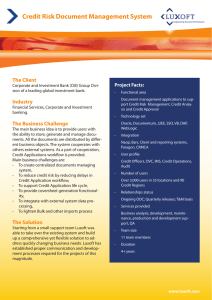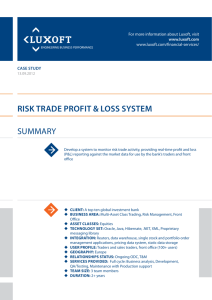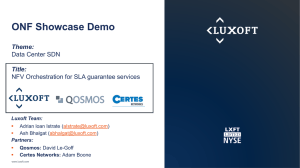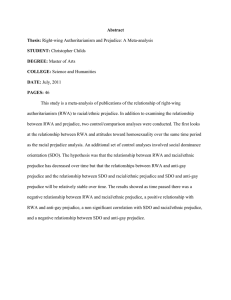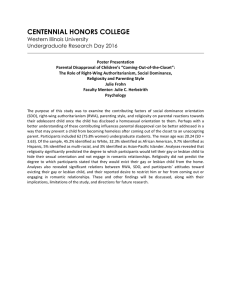Feed Consolidation Layer for Basel II Compliance Summary
advertisement
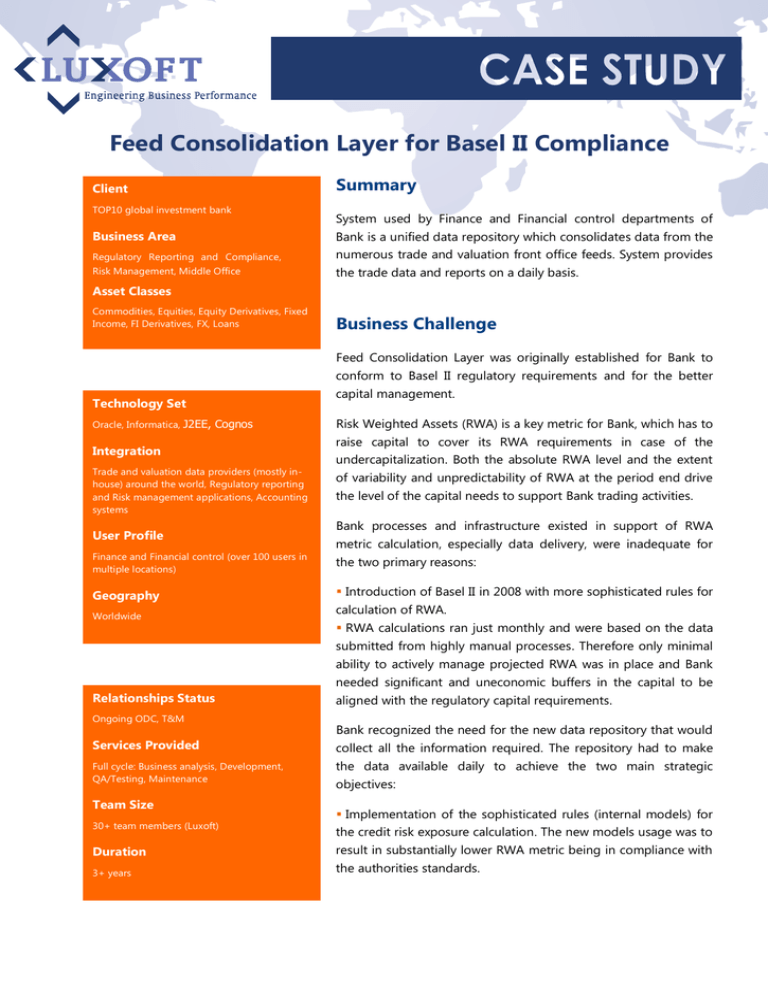
Feed Consolidation Layer for Basel II Compliance Client TOP10 global investment bank Summary System used by Finance and Financial control departments of Business Area Bank is a unified data repository which consolidates data from the Regulatory Reporting and Compliance, numerous trade and valuation front office feeds. System provides Risk Management, Middle Office the trade data and reports on a daily basis. Asset Classes Commodities, Equities, Equity Derivatives, Fixed Income, FI Derivatives, FX, Loans Business Challenge Feed Consolidation Layer was originally established for Bank to conform to Basel II regulatory requirements and for the better Technology Set Oracle, Informatica, J2EE, Cognos Integration Trade and valuation data providers (mostly inhouse) around the world, Regulatory reporting and Risk management applications, Accounting systems User Profile Finance and Financial control (over 100 users in multiple locations) Geography Worldwide capital management. Risk Weighted Assets (RWA) is a key metric for Bank, which has to raise capital to cover its RWA requirements in case of the undercapitalization. Both the absolute RWA level and the extent of variability and unpredictability of RWA at the period end drive the level of the capital needs to support Bank trading activities. Bank processes and infrastructure existed in support of RWA metric calculation, especially data delivery, were inadequate for the two primary reasons: Introduction of Basel II in 2008 with more sophisticated rules for calculation of RWA. RWA calculations ran just monthly and were based on the data submitted from highly manual processes. Therefore only minimal ability to actively manage projected RWA was in place and Bank needed significant and uneconomic buffers in the capital to be Relationships Status Ongoing ODC, T&M Services Provided Full cycle: Business analysis, Development, QA/Testing, Maintenance Team Size aligned with the regulatory capital requirements. Bank recognized the need for the new data repository that would collect all the information required. The repository had to make the data available daily to achieve the two main strategic objectives: Implementation of the sophisticated rules (internal models) for 30+ team members (Luxoft) the credit risk exposure calculation. The new models usage was to Duration result in substantially lower RWA metric being in compliance with 3+ years the authorities standards. Ability to calculate “flash” RWA intramonth. The need was to be supported by the both features: the ability to provide the data intramonth and the capability to run the calculation intramonth. The following requirements had to be met by the solution to support the business. Development of a unified data repository for consistent calculation and reporting on Bank's RWA. Consolidation of the trade details. Replacement of the direct front office application links with an indirect feed. Automatization of the manual extraction and enrichment processes for the front office trade capture and valuation systems. Unification of the daily and monthly processes to create the single straight-through process. The solution was intended to support the following strategic needs of Bank: Shift to weekly Basel II RWA calculation on the basis of the data available via the repository. Validation and correction of the data received earlier in the month. Significant reduction of RWA values and minimization of the safety buffer as the result of Basel II. Luxoft Delivered Solution Luxoft successfully took over the application existed and built up the comprehensive yet flexible solution to address all the business needs. System initially intended for the data for RWA calculations only for Finance and Financial Control became Golden Source for other reporting applications shortly. The solution implemented is scalable to allow new upstream systems to be added with the minimum efforts. The organizational structure of the project team is complex. The cross-companies development is applied in the project. The project team consists of the employees from Bank and the three vendors of the project including Luxoft as a subcontractor. The project management within the Luxoft scope is fulfilled by both Customer and Luxoft, with the Customer manager precedence. The project uses Hybrid (Staff & Project) work model. Luxoft provides core services as well as the project and process management. Few Luxoft team members work on-site while the others work in several locations off-site. Customer conducts his own project management and actively participates in the process management. One of the vendors (3 members) also provides the project management services. Another vendor (20+ members) provides only support of the ETL component. The iterative approach is implemented to deliver the project with the monthly releases. The product is developed as a set of the consecutive iterations. All iterations include a number of phases (Concept, Requirements and Scoping Management, Development, UAT and final Production) constrained by milestones. Iteration is finished when System with the expected functionality is deployed on Customer’s environment. The process of transferring the front office feeds from System is positioned as an Operational data store activity. System is not used as a data warehouse. System is to keep only the data necessary for operational business use. The main technologies applied in the project are Informatica as ETL tool (the support is provided by another vendor), Oracle as database, Java as coding platform and Cognos as reporting tool. System architecture is depicted below: System main data sources are the front office trade capture and daily valuation applications. Trade economics are available in real time. At the end of day the data staged during the day is joined with the valuation data. Customer has defined and developed the formats of all the feeds. Depending on the type of source system, feeds can be divided as follows: File Based Feeds (mainly CSV and TXT files). Message Based Feeds (XML messages). Mixed Data Feeds (CSV and TXT files, as well as XML messages). The collection of Feed handler components ensures the data is handled once received from the source systems and made available to the ETL component. Informatica implements the ETL functionality which performs the transformation and validation processes and publishes the data processed to the Outbound Data Store (ODS). System processes rely on the data mappings and workflows created by Informatica Power Center. Data Quality subsystem is an integral part of the solution intended to monitor all the incoming data and to create special exceptions in case of the events. The subsystem exploits rule-based approach for the data analysis and provides the dedicated reports on the data quality via Cognos technology. Adjustment tool closely coupled with System provides the users the opportunity to make manual reconciliations and adjustments via the web-based interface. The data processed by System is made available to the downstream applications via ODS. There are several main downstream systems, two of which are developed by Luxoft along with System: Credit Risk Reporting tool which performs calculation based on Basel II requirements and provides different reports via Cognos based subsystem. IFRS 7 Disclosures Reporting tool which provides the information for IFRS 7 compliance purposes. The other downstream applications are used for accounting purposes reporting. Benefits Luxoft provided System in accordance with the schedule and on budget. Bank successfully aligned with Basel II requirements and benefited from using Basel II instead of Basel I calculated RWA, as well as received the great tool to actively manage unpredictability of RWA. Bank was provided with a highly flexible web-based strategic solution that substituted the tactically oriented ones. The solution can be easily enhanced to effectively provide new services. Luxoft was developing this solution on the step-by-step basis, providing a smooth transition to the new platform in accordance with the schedule. Luxoft improved the effectiveness of the business processes being implemented by System with the boosted performance. Bank was able to eliminate the manual error-prone processing owing to System production. Customer Feedback The detailed feedback is provided upon the specific request.
